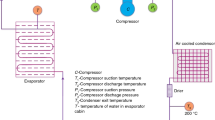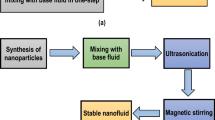Abstract
The primary source of energy consumption in a vapour compression refrigeration system is a compressor. The possibility of a reduction in the work of compression may leads to enhance the compressor suction and discharge characteristics and the overall performance of the refrigeration system. The present experimental investigation based upon the study of ZnO nanoparticles in a vapour compression refrigeration system using hydrocarbon blend R290/R600a (50/50) as a refrigerant. The zinc oxide nanoparticles are appended with system refrigerant via compressor lubricating oil. The results observed that by using different weight concentrations of nanoparticles in R290/R600a refrigeration system, both the compressor suction and discharge pressures and temperatures were reduced compared to conventional system. The viscosity of mineral oil with the addition of nanoparticles increases. The compressor energy consumption was reduced by 7.48 % using (0.2–1.0) wt% concentrations of nanoparticles. The COP of the refrigeration system has been increased by about 46 % with the addition of nanoparticles. Thus, the ZnO nanoparticles worked efficiently in the R290/R600a refrigeration system.












Similar content being viewed by others
Abbreviations
- m:
-
Mass of water [kg]
- ΔT:
-
Temperature difference
- t:
-
Time [sec]
- Cp :
-
Specific heat capacity [kJ Kg−1 K−1
- K:
-
Energy meter constant [Imp. kW−1 h−1]
- n:
-
Number of pulses taken in energy meter
References
KJ Wang, GL Ding, WT Jiang (2006) Nano-scale thermal transporting and its use in engineering. In: Proceedings of 4th symposium on refrigeration and air conditioning, Southeast University
Bobbo S, Fedele L, Fabrizio M, Barison S, Battiston S, Pagura C (2010) Influence of nanoparticles dispersion in POE oils on lubricity and R134a solubility. Int J Refrigeration 33:1180–1186
Xiao-Min WU, Peng LI, Hui LI, Wei-Cheng WANG (2008) Investigation on pool boiling heat transfer of R11 with TiO2 nanoparticle. J Eng Thermophys 28:124–126
Park KJ, Jung DS (2007) Boiling heat transfer enhancement with carbon nanotubes for refrigerants used in building air conditioning. Energy Build 39(9):1061–1064
Bi S.S, Yong H.L, Shi L (2005) An investigation on the compatibility of nonmetallic materials with HFC-134a and mineral oil appended with nano-particle TiO2.In: Proceedings of the 5th international conference proceedings. pp 409–416
Hao P, Guoliang D, Haitao H, Weiting J, Dawei Z, Kaijiang W (2010) Nucleate pool boiling heat transfer characteristics of refrigerant/oil mixture with diamond nanoparticles. Int J Refrigeration 33:347–358
Mahbubul IM, Saidur R, Amalina MA (2013) Influence of particle concentration and temperature on thermal conductivity and viscosity of Al2O3/R141b nanorefrigerant. Int commun Heat Mass 43:100–104
Mahbubul IM, Saidur R, Amalina MA (2012) Investigation of Viscosity of R123-TiO2 nanorefrigerant. Int J Mech Mater Eng 7:146–151
Jiang WT, Ding GL, Peng H (2009) Measurement and model on thermal conductivities of carbon nanotube nanorefrigerants. Int J Thermal Sci 48:1108–1115
Peng H, Ding G, Jiang W, Hu H, Gao Y (2009) Measurement and correlation of frictional pressure drop of refrigerant based nanofluids flow boiling inside a horizontal smooth tube. Int J Refrigeration 32:1756–1764
Bi Shengshan, Guo Kai, Liu Zhigang, Jiangtao Wu (2011) Performance of a domestic refrigerator using TiO2—R600a nanorefrigerant as working fluid. Energy Convers Manag 52:733–737
Kumar DS, Elansezhian RD (2012) Experimental study on Al2O3-R134a nano refrigerant in refrigeration system. Int J Mod Eng Res 2(5):3927–3929
Kumar DS, Elansezhian R (2013) ZnO nanorefrigernt in R152a refrigeration system for energy conservation and green environment. Front Mech Eng 9(1):75–80
Singh K, Lal K (2014) An investigation into the performance of a nanorefrigerant (R134a + Al2O3) based refrigeration system. IJRMET 4(2):158–162
Kedzierski MA (2009) Effect of CuO nanoparticle concentration on R134a/lubricant pool boiling heat transfer. ASME J Heat Transf 131:043205
Sun B, Yang D (2013) Experimental study on the heat transfer characteristics of nanorefrigerants in an internal thread copper tube. Int J Heat mass Trans 64:559–566
Tang X, Zhai YH, Diao YH (2014) Experimental investigation of the gamma- Al2O3-R141b nanofluids on a horizontal plate. Exp Therm Fluid Sci 52:88–96
Kumar DD, Elansezhian RD (2012) Experimental study on Al2O3-R134a nanorefrigerant in refrigeration system. Int J Mod Eng Res 2(5):3927–3929
Naphon P, Thongkurn D, Assadamongkol P (2009) Heat pipe efficiency enhancement with refrigerant-nanoparticles mixture. Energy cons Mang 50:772–776
Javadi FS, Saidur R (2013) Energetic, Economic and environmental impacts of using nanorefrigerant in domestic refrigerators in Malaysia. Energy Cons Manag 73:335–339
Xiaodong Z, Xun Fu, Huaqiang Shi et al (2007) Lubricating properties of cyanox 302 modified MoS2 micospheres in base oil 500SN. Lubr Sci 19:71–79
Xing M, Wang R, Yu J (2014) Application of fullerene C60 nano-oil for performance enhancement of domestic refrigerator compressors. Int J Refrigeration 35:398–403
Krishna Sabareesh R, Gobinath N, Sajith V, Das S, Sobhan CB (2012) Application of TiO2 nanoparticles as a lubricant additive for vapour compression refrigeration system- An experimental investigation. Int J Refrigeration 35:1989–1996
Author information
Authors and Affiliations
Corresponding author
Rights and permissions
About this article
Cite this article
Kumar, R., Singh, J. Effect of ZnO nanoparticles in R290/R600a (50/50) based vapour compression refrigeration system added via lubricant oil on compressor suction and discharge characteristics. Heat Mass Transfer 53, 1579–1587 (2017). https://doi.org/10.1007/s00231-016-1921-3
Received:
Accepted:
Published:
Issue Date:
DOI: https://doi.org/10.1007/s00231-016-1921-3




